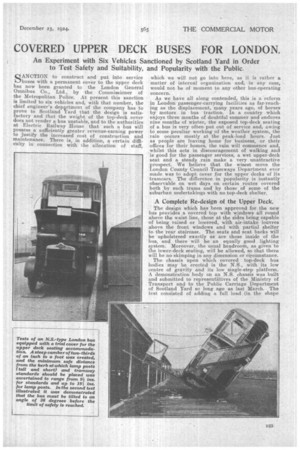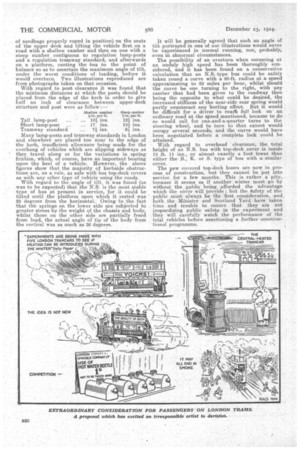COVERED UPPER DECK BUSES FOR LONDON.
Page 9

Page 10

If you've noticed an error in this article please click here to report it so we can fix it.
An Experiment with Six Vehicles Sanctioned by Scotland Yard in Order to Test Safety and Suitability, and Popularity with the Public.
SANCTION to construct and put into service buses with a permanent cover to the upper deck has now been granted to the London General Omnibus Co., Ltd., by the Commissioner of the Metropolitan Police. At present this sanction is limited to six vehicles and, with that number, the chief engineer'sdepirtment of the company has to prove to Scotland Yard that the design is satisfactory and that the weight of the top-deck cover does not render a bus unstable, and to the authorities at Electric Railway House that such a bus will possess. a sufficiently greater revenue-earning power to .justify the increased cost of construction and maintenance. There is, in addition, a certain difficulty in connection with the allocation of staff,
which we will not go into here, as it is rather a matter of internal organization and, in any case, would not be of moment to any other bus-operating concern.
As we have all along contended, this is a reform in London passenger-carrying facilities as far-reaching as the displacement, many years ago, of horses by motors in bus traction. In a country which enjoys three months of doubtful summer and endures nine months of winter, the exposed top-deck seating of a bus is very often put out of service and, owing to some peculiar working of the weather system, the rain occurs mostly at the peak-load hours. Just as people are leaving home for business, or their offices for their homes, the rain will commence and, whilst this acts in discouragement of walking and is good for the passenger services, a wet upper-deck seat and a steady rain make a very unattractive prospect. We believe that the wisest move the London County Council Tramways Department ever made was to adopt cover for the upper decks of its tramcars. The difference in popularity is instantly observable on wet days on certain routes covered both by such trams and by those of some of the suburban undertakings with no top-deck shelter.
A Complete Re-design of the Upper Deck.
The design which has been approved for the new bus provides a covered top with windows all round above the waist line, those at the sides being capable of being raised or lowered, with air-intake louvres above the front windows and with partial shelter to the rear staircase. The seats and seat backs will be upholstered exactly as are those inside of the bus, and there will be an equally good lighting system. Moreover, the usual headroom, as given to the lower-deck seating, will be allowed, so that there will be no skimping in any dimension or circumstance. The chassis upon which covered top-deck bus bodies may be erected is the N.S., with its low centre of gravity and its low single-step platform. A demonstration body on an N.S. chassis was built and submitted to representatives of the Ministry of Transport and to the Public Carriage Department of Scotland Yard so long ago as last March. The test consisted of adding a full load (in the shape of sandbags properly roped in position} on the seats of the upper deck and tilting the vehicle first on a road with a shallow camber and then on one with a steep camber contiguous to regulation lamp-posts and a regulation tramway standard, and afterwards on a platform, canting the bus to the point of balance so as to ascertain the maximum angle of tilt, under the worst conditions of loading, before it would overturn. Two illustrations reproduced are from photographs taken on that occasion.
With regard to post clearance it was found that the minimum distances at which the posts should be placed from the edge of the kerb in order to give half an inch of clearance between upper-deck structure and post were as follow :—
Shallow camber Steep camber i-in. per ft, ?de. per ft.
Tall lamp-post ,.. 101 ins. 12* ins. Short lamp-post ... ... 17 ins. 18i ins.
Tramway standard ... 71 ins. 91 ins.
Many lamp-posts and tramway standards in London and elsewhere are placed too near to the edge of the kerb, insufficient allowance being made for the overhang of vehicles which are slipping sideways as they travel along or for the variations in spring friction, which, of course, have an important bearing upon the heel of a vehicle. However, the above figures show that the majority of kerbside obstructions are, as a rule, as safe with bus top-deck covers as with any other type of vehicle using the roads.
With regard to the angle of tilt, it was found (as was to be expected) that the N.S. is the most stable type of bus at present in service, for it could be tilted until the platform upon which it rested was 28 degrees from the horizontal. Owing to the fact that the springs on the lower side are subjected to greater stress by the weight of the chassis and body, whilst those on the other side are partially freed from load, the actual angle of tip of the body from the vertical was as much as 36 degrees.
It will be generally agreed that such an angle of tilt portrayed in one of our illustrations would never be experienced in normal running, nor, probably, even in abnormal circumstances.
The possibility of an overturn when cornering at an unduly high speed has been thoroughly considered, and it has been found on a conservative calculation that an N.S.-type bus could be safety taken round a curve with a 60-ft. radius at a speed approximating to 22 miles per hour, whilst should the curve be one turning to the right, with any, camber that had been given te the roadway then being the opposite to what could be desired, the increased stiffness of the near-side rear spring would partly counteract any heeling effect. But it would be difficult for a driver to reach full lock on an ordinary road at the speed mentioned, because to do so would call for one-and-a-quarter turns to the steering wheel, and to turn to that extent would occupy several seconds, and the curve would have been negotiated before a complete lock could be attained.
With regard to overhead clearance, the total height of an N.S. bus with top-deck cover is inside 13 ft. 11 ins., or almost exactly a foot lower than either the B., K. or S. type of bus with a similar cover.
The tew covered top-deck buses are now in process of construction, but they cannot be put into service for a few months. This is rather a pity, because it seems as if another winter must go by without the public being afforded the advantage which the cover will provide : but the ftafety, of the public must always be the first consideration, and, both the Ministry and Scotland Yard have taken time and trouble to ensure that they are not jeopardizing public safety in the experiment and they will carefully watch the performance of the trial vehicles before sanctioning a further constructional programme.
































